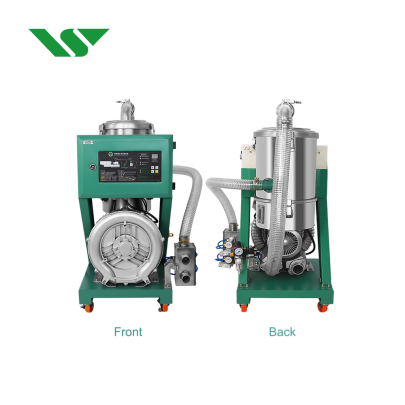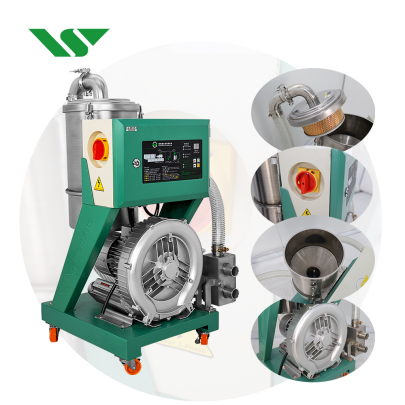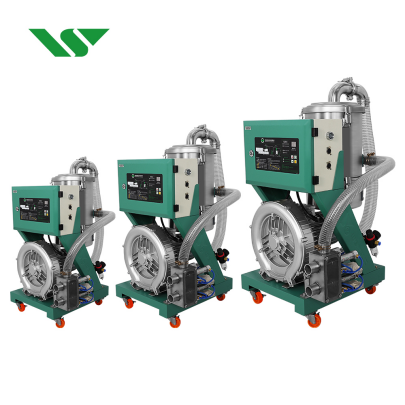Common Problems and Solutions in Centralized Plastic Pellet Conveying Systems
2024-11-14 Page view:
Centralized conveying systems are essential in plastic manufacturing, providing a streamlined way to move plastic pellets and other raw materials consistently and reliably. However, these systems are complex and not immune to issues that can disrupt production and lead to costly downtime. Understanding the common problems in centralized pellet conveyance can help operators preemptively address potential issues. In this article, we'll examine the primary challenges in these systems and offer insights on how to keep operations running smoothly.

Common Pump Issues in Centralized Pellet Conveyance
The pump is a critical component in centralized conveying systems. Problems with pump operation can significantly disrupt the flow of materials, leading to reduced efficiency. Here are some of the most common pump-related issues:
Dust Buildup in Collection Buckets: Excess dust in collection buckets can block filters and restrict airflow, causing the pump to work harder than it should.
Electrical and Motor Issues: Problems with contactors, thermal overloads, or an unbalanced power supply can result in motor jams or overheating, both of which impact pump performance.
Valve Malfunctions: A faulty pressure relief or mechanical valve on the dust collection bucket can cause overheating, further exacerbating pump strain.
Regular maintenance of filters, contactors, and valves can help keep the pump in good working condition, ensuring a steady flow of materials.

Addressing Conveyance Flow Issues
Conveyance flow issues are often caused by a lack of sufficient airflow or air pressure in the system, which can interrupt pellet transportation. Some common causes include:
Blocked Filters in the Dust Collection System: Clogged filters reduce the system's suction power, making it harder to transport materials effectively.
Pneumatic Valve Failures: Pneumatic valves that fail to open or close properly disrupt the flow of pellets in the system.
Pipeline Leaks: Any leaks in shared air or material pipes reduce air pressure, making it challenging to convey materials consistently.
Routine inspections and maintenance of filters, valves, and pipelines can help identify and resolve these issues before they escalate.
Power Supply Inconsistencies
For optimal performance, centralized conveying systems rely on a consistent and balanced power supply. Any issues with the power supply can cause irregularities in material flow, such as:
Unbalanced Phases: If the three-phase 380V power supply is unbalanced (e.g., with two phases at 380V and one at 220V), it can cause the motor to overheat or jam.
Phase Loss: Missing one phase of power can drastically reduce system efficiency and cause unexpected shutdowns.
Monitoring the power supply and addressing any inconsistencies helps prevent unnecessary strain on the motor, improving the longevity of the system.

Sensor and System Parameter Issues
Sensor and system parameter settings are essential for accurate material conveyance. Issues in these areas can lead to inefficient operation or even system shutdowns:
Faulty Photoelectric Sensors: If the system does not sense when a material cup is full, it may continue running unnecessarily, wasting energy and risking overloading.
Incorrect Parameter Settings: Incorrect settings in system parameters can cause improper timing, which may lead to material blockages or incomplete material conveyance.
Inconsistent Compressed Gas Supply: Insufficient compressed gas can prevent pneumatic valves from operating correctly, which disrupts conveyance.
By regularly calibrating sensors, checking system parameters, and ensuring a steady compressed gas supply, operators can maintain optimal system efficiency and reduce errors.
Conclusion
Centralized conveying systems offer reliable and continuous material transport, but they do require regular maintenance to avoid breakdowns. By understanding the common challenges-- such as pump issues, conveyance flow problems, power supply inconsistencies, and sensor malfunctions-- operators can take proactive steps to minimize downtime and ensure smooth operation. With proper maintenance and monitoring, these systems can continue to support production efficiently, ensuring consistent output and reducing the risk of costly interruptions.



